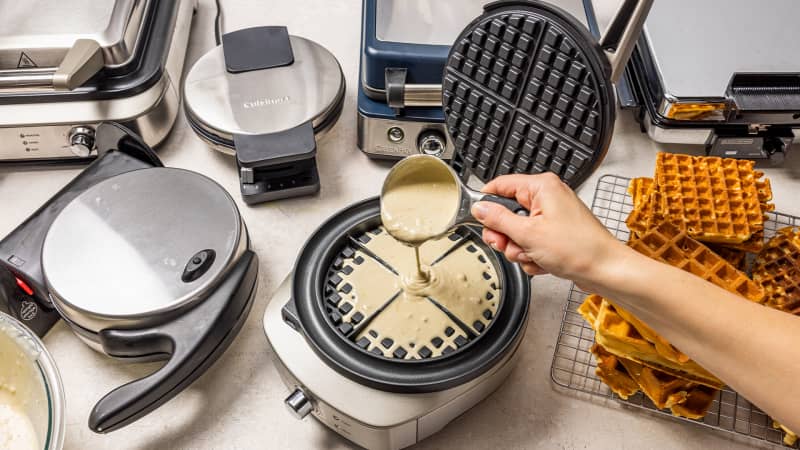Best Buttermilk Waffles
Recipe
We wanted a waffle maker that made great waffles and was a breeze to use. We tested a wide range of classic and Belgian-style waffle irons to find the best.
Last Updated Apr. 11, 2024. Appears in America's Test Kitchen TV Season 17: The Ultimate Sticky Buns

Readers have been asking us to review waffle makers that make thinner classic waffles, so we put some to the test. The Breville No-Mess Waffle Maker is our winning classic waffle maker. Its simple control panel is easy to use and produces great, if slightly thicker, classic waffles. We also tested a few additional Belgian-style waffle makers and the Breville Smart Waffle 4 Slice is our new winner. It makes perfect waffles that are thick, crisp on the outside, and moist on the inside. The Presto FlipSide Belgian Waffle Maker is our Best Buy. It costs a fraction of the price of our winner; is very easy to use; and makes beautiful, thick Belgian waffles. However, it sometimes drips hot condensation when flipped.
Waffle makers for home cooks come in two main styles: classic machines that make shorter waffles with shallow indents, and Belgian-style machines that make thick waffles with bigger indents. Regardless of style, the best models are easy and safe to use and produce golden, evenly-browned waffles.
Our winning Belgian-style waffle maker is the Breville Smart Waffle 4 Slice. It is easy to use, has audible and visual alerts, and makes gorgeous thick waffles.
The Presto FlipSide Belgian Waffle Maker is our Best Buy, and it makes golden Belgian waffles that are even thicker than our winner’s. It sometimes drips hot condensation when flipped, so it requires a little extra caution when using.
For those who prefer thinner waffles, our winning classic waffle maker is the Breville No-Mess Waffle Maker. While the waffles it made are on the thicker side for a classic style, they were evenly browned and perfectly crisp.
What You Need to Know
Waffles are usually a weekend morning treat—a step up from pancakes but a little more hands-off than French toast. Unlike either of those breakfast items, you need a dedicated waffle iron to make them. Electric waffle irons are the easiest to use; good models are essentially plug-and-play. Most models have a power button and a dial to select the darkness or crispness you want your waffle cooked to. Some also have additional settings for various types of waffles. Select your setting; pour in your batter; and a few minutes later, you have a golden, crisp waffle.
There are two main types of waffle irons. Classic waffle irons make thinner waffles that measure less than an inch in height and have shallower indents. They’ve decreased in popularity somewhat over the years, however, so there are fewer on the market. Belgian waffle irons are now more widely available; they make taller waffles that measure at least an inch in height and have deeper indents.
Belgian waffle irons can work in two different ways. With flip- and rotary-style models, the machine either turns on a hinge or spins 180 degrees on a stand. By contrast, stationary models simply open and close on a hinge.
What to Look For

The mission of America’s Test Kitchen Reviews is to find the best equipment and ingredients for the home cook through rigorous, hands-on testing. We stand behind our winners so much that we even put our seal of approval on them.

Miye is a senior editor for ATK Reviews. She covers booze, blades, and gadgets of questionable value.

Sawyer is an assistant digital editor for ATK Reviews. She enjoys baking, collecting Prince records, and all things Toni Morrison.

Sarah is an assistant editor for ATK Reviews who is deeply passionate about anchovies and sourdough bread.

This is a members' feature.